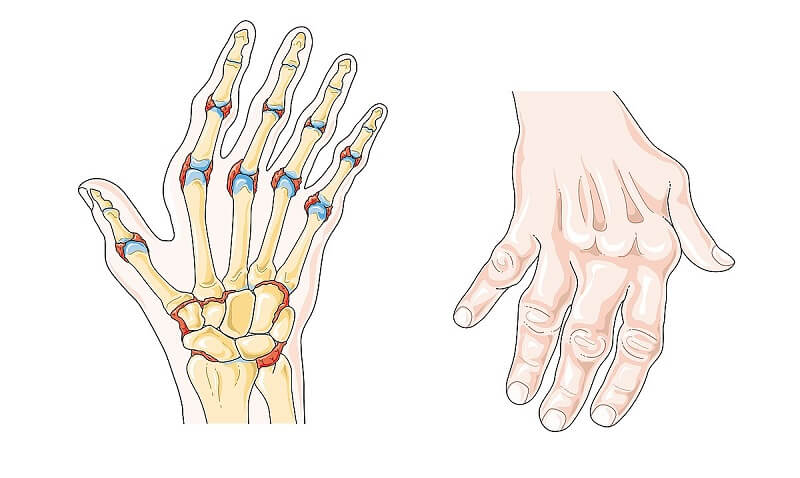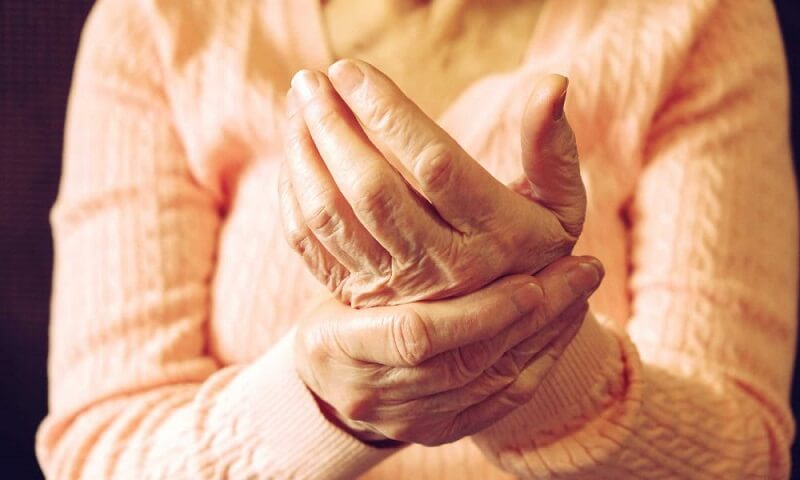Rheumatoid arthritis is a complicated disease that cannot be completely cured, affecting joint function and causing inconvenience in the mobility of the patient.
If the disease is not treated in time, it can cause serious consequences. Therefore, understanding rheumatoid arthritis and effective prevention and treatment methods is an important thing to protect the health of every person.
What Is Rheumatoid Arthritis?
Rheumatoid Arthritis is an autoimmune disease with a chronic course caused by the immune system mistakenly attacking the tissues of the body. Candlestick.
Rheumatoid arthritis occurs will cause swelling, joint pain, damage all over the body, commonly known as shoulder joint pain, knee joint pain, foot joints, back and arm joints. Unlike osteoarthritis, which will cause wear and tear and damage to joints, rheumatoid arthritis also causes more severe effects, affecting the mucosal layer, causing damage, swelling, and pain.

The end result is that bones and joints are eroded, osteoarthritis, deformed joints, affecting daily activities when using force in joints such as carrying heavy objects, walking, writing, typing … For inflammation in the hip, knee, ankle joints, the normal movement of the patient will be much more difficult.
As the disease progresses to a more advanced stage, not only does the joints damage, which can lead to loss of function, but also affects other parts of the body such as blood vessels, skin, lungs, heart, and eyes.
Currently, rheumatoid arthritis has an increasing rate, it is common in adults in the age group from 20 to 40 years old, on average about 1 to 5 adults are affected by the disease. But the most common is still women, pregnant women have a higher incidence of 2-3 times compared to men.
Complications of Rheumatoid Arthritis
Rheumatoid arthritis has complicated developments, causing serious effects to the patient if it is not treated promptly and monitored according to each disease stage. Complications of rheumatoid arthritis that patients may encounter are:
Restriction of movement: When the joints are inflamed, swelling and pain will cause stiffness in the joints, making movement and walking of the patient restricted, when moving a lot will cause serious pain, causing severe pain. reduce the body's resistance, if the condition gets worse, it will lose the ability to work for some specific occupations, etc.

Disability: Adhesion of joints, muscle atrophy, complications of joints, and the risk of disability are serious complications of long-term untreated rheumatoid arthritis. According to statistics, up to 89% of cases of patients have stiffness, difficulty in moving, and difficulty holding after a period of 10 years of illness.
Decreased conception rate: Rheumatoid arthritis is also the reason why women have difficulty conceiving, this rate accounts for about 25%.
Increased risk of cardiovascular disease: In rheumatoid arthritis, patients also face the risk of cardiovascular disease leading to serious complications, more dangerous than death if left uncontrolled. strictly follow the treatment regimen.
Evolution of Rheumatoid Arthritis
Symptoms of rheumatoid arthritis will have different manifestations according to the degree of progression of each stage of the disease.
Specifically, rheumatoid arthritis will have 4 stages as follows:
Stage 1: The patient has swelling and pain in the joints caused by inflammation of the membrane on the joint. At the same time, in synovial fluid, the number of cells increases as immune cells migrate to the inflamed area.
Stage 2: Moderate rheumatoid arthritis, usually no joint deformities occur. For stage 2, an increase in inflammation in the tissue is observed, and spread to surrounding areas begins. The space in the affected joint and on the affected cartilage shrinks and is gradually destroyed as the bone tissue begins to develop.
Stage 3: Stage 3 rheumatoid arthritis is considered a severe form, the loss of joint cartilage not only cause serious damage to the joints but also exposes bone under the cartilage.
The patient will feel pain in the joint, the painful area is swollen, difficult to move, often have stiffness in the morning, muscle atrophy, have deformed nodules form, the body is tired and begins to develop. signs of weakness.

Stage 4: This is also the last and most severe stage of rheumatoid arthritis. Upon entering this stage, the inflammation shows signs of diminishing, but slack bones and fibrous tissues begin to cause a joint function to stop working.
Rheumatoid arthritis has the typical symptoms that people easily recognize as a feeling of stiffness and pain in the joints, often painful when waking up or sitting for a long time in a position. With a lot of movement, the pain in the joints will decrease.
In addition, in some cases, the patient also feels that the person is tired, weak, sometimes has a high fever, itchy or painful eyes, pimples in the legs, no appetite, short breathing, tingling. Observed in the painful joint can see red skin, swelling, soft, and hot …
Diagnosis of Rheumatoid Arthritis
In the early stages, rheumatoid arthritis is difficult to diagnose because the sign often confuses it with another disease. Symptoms of the disease are often poor, when the deformed joints, painful swelling are noticed, the disease is in a late stage.
Currently, most countries, including Vietnam, often rely on the standards of the American College of Rheumatology (ACR) to diagnose rheumatoid arthritis with time and disease progression 6 weeks or more.
- The patient has stiffness in the morning lasting more than 1 hour.
- Inflammation of at least 3 groups of joints in 14 groups of joints including hands, wrists, ankles, toes, knees, elbows, toes (on both sides).
- In the inflamed joints, there is at least one joint of the joint position in the hand: the finger, wrist, near finger.
- Arthritis is symmetrical.
- Seeds under the skin.
- The rheumatoid factor in the serum gave a positive result (95% specificity).
- X-ray with typical signs at the location of wrist bone mass: Image of erosion, narrowing of joints, cavity-shaped and especially loss of head-bone minerals.
Definite diagnosis: The duration of the course of arthritis must be more than 6 weeks and have at least 4 out of 7 criteria, as determined by the specialist.
Testing for rheumatoid arthritis includes a blood test and imaging tests like the following:
Blood test: For patients with rheumatoid arthritis, through blood tests often show reactive protein or an increased sedimentation rate of erythrocytes, the presence of the myositis process occurs …
Imaging tests: Musculoskeletal imaging, musculoskeletal ultrasound can help doctors track the progression of rheumatoid arthritis over time. MRI and ultrasound are also important diagnostic tests to help evaluate the level of the disease at any stage.
Treatment of Rheumatoid Arthritis

There is currently no cure for rheumatoid arthritis that can be completely cured. The disease often has complicated developments, causing many health effects, so it should be diagnosed and treated promptly.
The applied measures are to prevent complications by improving symptoms, helping the patient to improve the quality of life, and limit the effects of the disease on daily activities such as drug treatment, exercise. physical therapy, osteoarthritis, surgery …
1. Drug Treatment
According to many studies, when treated with drugs at an early stage, it is possible to significantly reduce symptoms. Medications for rheumatoid arthritis used depending on the severity of the disease prescribed and recommended by your doctor often include:
- Nonsteroidal anti-inflammatory drugs – NSAIDs help patients reduce inflammation and pain, but can cause some side effects such as stomach irritation, kidney and heart damage, increased risk of bleeding …
- Corticosteroids help slow joint damage and reduce pain and inflammation. Some of the possible side effects are weight gain, osteoporosis, diabetes.

- DMARDs – disease-modifying anti-rheumatic drugs that inhibit the development of rheumatoid arthritis and limit joints and tissues from the risk of permanent damage. Possible side effects are bone marrow suppression, liver damage, lung infection …
- Biological drugs: Applied depending on the case, used when the patient does not respond to another group of drugs, significantly improving the condition.
2. Surgery
In the event that the patient is given medication but cannot reduce the development of the disease-causing joint damage, the doctor will consider surgical indications to help repair the damaged joints, restore the ability to use the joints. and at the same time improving joint function and reducing pain in the patient.
Surgery may include case-based surgeries such as:
- Endoscopic surgery.
- Repair of tendons.
- Orthopedic surgery.
- Replace all joints.
In addition, many patients are concerned with the problem of treating rheumatoid arthritis with traditional medicine or treating rheumatoid arthritis with traditional medicine.

The treatment of rheumatoid arthritis with Oriental medicine usually costs less than Western medicine treatment with natural and easy-to-find remedies. However, this is a method that requires a long time, with slow results, often used in the period of remission or prevention.
When the disease is progressing rapidly, causing serious effects, anti-inflammatory drugs are needed to prevent and improve the disease according to the doctor's treatment regimen.
You can refer to the male remedies for rheumatoid arthritis, but you need to consult a specialist about this, avoid misuse, some remedies are only through word of mouth. Many hidden risks can make the condition worse, making it difficult to treat.
Rheumatoid arthritis is a disease that can not be completely cured, causing serious health effects if the disease is in a late stage. Therefore, recognizing signs of disease at an early stage, and visiting the hospital immediately when there is an unusual problem, helps to limit dangerous complications, improve the disease effectively, to protect health.
For more information about our test menu and price list, please click here.
The site cannot and does not contain medical advice. The medical information is provided for general informational and educational purposes only and is not a substitute for professional advice. Accordingly, before taking any actions based upon such information. We encourage you to consult with the appropriate professionals.

 1900 1717
1900 1717 